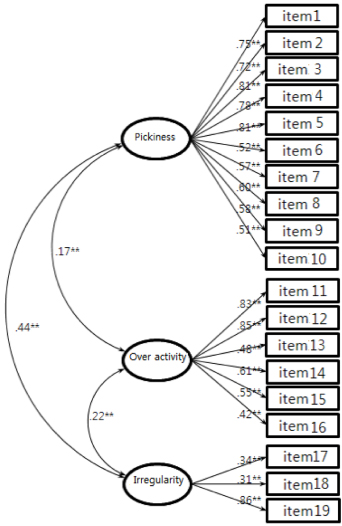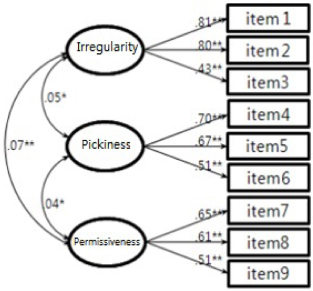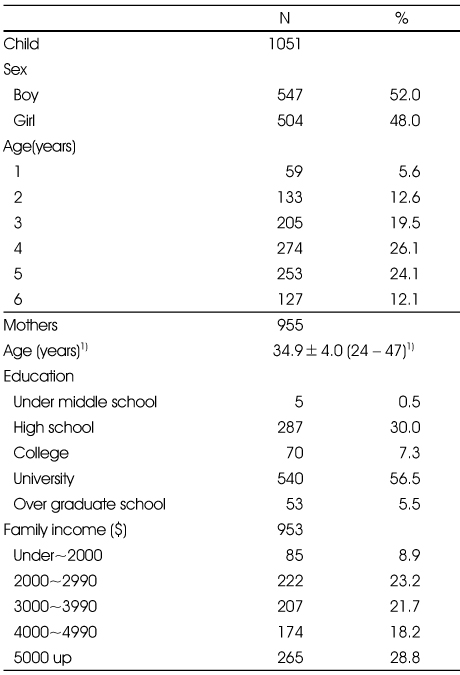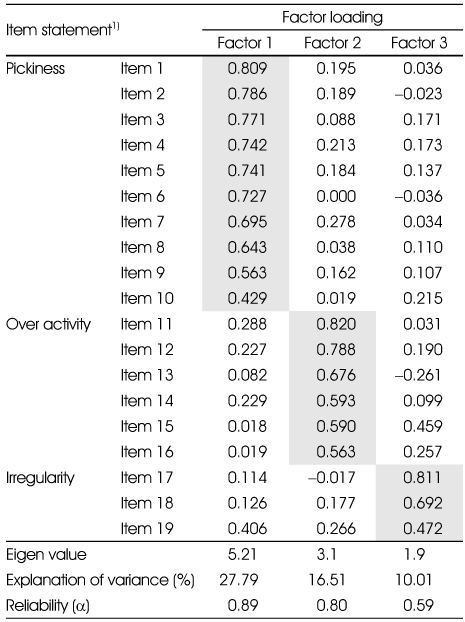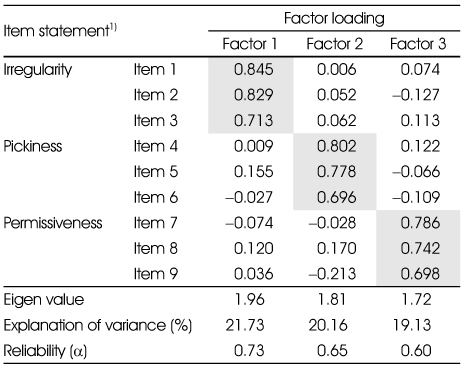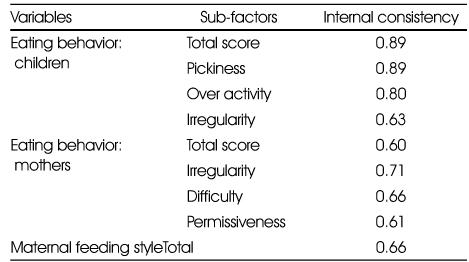References
1. Baek KS. A study on children's adjustment to full-time daycare center. Doctorate Thesis Sookmyung Women's University; 1996.
2. Bentler PM. Comparative fit indexes in structural models. Psychol Bull 1990;107(2):238–246.
3. Birch LL, Fisher JO. Development of eating behaviors among children and adolescents. Pediatrics 1998;101(3 Pt 2):539–549.
4. Blissett J, Fogel A. Intrinsic and extrinsic influences on children's acceptance of new foods. Physiol Behav 2013;121:89–95.
5. Chatoor I, Ganiban J, Hirsch R, Borman-Spurrell E, Mrazek DA. Maternal characteristics and toddler temperament in infantile anorexia. J Am Acad Child Adolesc Psychiatry 2000;39(6):743–751.
6. Chess S, Thomas A. Temperamental individuality from childhood to adolescence. J Am Acad Child Psychiatry 1977;16(2):218–226.
7. Dunn W. The impact of sensory processing abilities on the daily lives of young children and their families: a conceptual model. Infants Young Child 1997;9(4):23–35.
8. Farrow CV, Coulthard H. Relationships between sensory sensitivity, anxiety and selective eating in children. Appetite 2012;58(3):842–846.
9. Fullard W, McDevitt SC, Carey WB. The relationship between parental literacy level and perception of emergent literacy. J Read Behav 1984;23(2):191–213.
10. Gibson EL, Wardle J, Watts CJ. Fruit and vegetable consumption, nutritional knowledge and beliefs in mothers and children. Appetite 1998;31(2):205–228.
11. Hagekull B, Bohlin G, Rydell AM. Maternal sensitivity, infant temperament, and the development of early feeding problems. Infant Ment Health J 1997;18(1):92–106.
12. Harper LV, Sanders KM. The effect of adults' eating on young children's acceptance of unfamiliar foods. J Exp Child Psychol 1975;20(2):206–214.
13. Hendy HM, Raudenbush B. Effectiveness of teacher modeling to encourage food acceptance in preschool children. Appetite 2000;34(1):61–76.
14. Hetherington MM, Schwartz C, Madrelle J, Croden F, Nekitsing C, Vereijken CM, Weenen H. A step-by-step introduction to vegetables at the beginning of complementary feeding. The effects of early and repeated exposure. Appetite 2015;84:280–290.
15. Johnson SL, Birch LL. Parents' and children's adiposity and eating style. Pediatrics 1994;94(5):653–661.
16. Kim Y, Han Y, Chung S, Lee Y, Lee S, Choi H. Characteristics of infants' temperaments and eating behaviors, mothers' eating behaviors and feeding practices in poor eating infants. Korean J Community Nutr 2006;11(4):449–458.
17. Kim YJ, Chung S, Han Y, Lee Y, Lee S, Byun K, Choi H. The characteristics of infants' temperament, maternal feeding behavior and feeding practices in picky eaters. Korean J Community Nutr 2005;10(4):462–470.
18. Kwon SH. Multivariate data analysis-using SPSS Daejeon: Hannam University Press; 2005.
19. Lee MS. The effects of temperament and peer-support on the self-evaluation of early adolescents. Dissertation Yonsei University; 1994.
20. Moding KJ, Birch LL, Stifter CA. Infant temperament and feeding history predict infants' responses to novel foods. Appetite 2014;83:218–225.
21. Morrison H, Power TG, Nicklas T, Hughes SO. Exploring the effects of maternal eating patterns on maternal feeding and child eating. Appetite 2013;63:77–83.
22. Pliner P, Hobden K. Development of a scale to measure the trait of food neophobia in humans. Appetite 1992;19(2):105–120.
23. Pliner P, Loewen ER. Temperament and food neophobia in children and their mothers. Appetite 1997;28(3):239–254.
24. Putnam SP, Gartstein MA, Rothbart MK. Measurement of fine-grained aspects of toddler temperament: the early childhood behavior questionnaire. Infant Behav Dev 2006;29(3):386–401.
25. Rollins BY, Loken E, Savage JS, Birch LL. Effects of restriction on children's intake differ by child temperament, food reinforcement, and parent's chronic use of restriction. Appetite 2014;73:31–39.
26. Saslow ER. Temperament and day care: an examination of differences in expression across settings. Dissertation Temple University; 1993.
27. Steiger JH. Structural model evaluation and modification: aninterval estimation approach. Multivariate Behav Res 1990;25(2):173–180.
28. Stunkard AJ, Messick S. The three-factor eating questionnaire to measure dietary restraint, disinhibition and hunger. J Psychosom Res 1985;29(1):71–83.
29. Sullivan SA, Birch LL. Infant dietary experience and acceptance of solid foods. Pediatrics 1994;93(2):271–277.
30. Windle M. Temperament and social support in adolescence: interrelations with depressive symptoms and delinquent behaviors. J Youth Adolesc 1992;21(1):1–21.
31. Wright DE, Radcliffe JD. Parents' perceptions of influences on food behavior development of children attending day care facilities. J Nutr Educ 1992;24(4):198–201.
32. Yang BH. Understanding multivariate data analysis Seoul: Communication Books; 2006.
